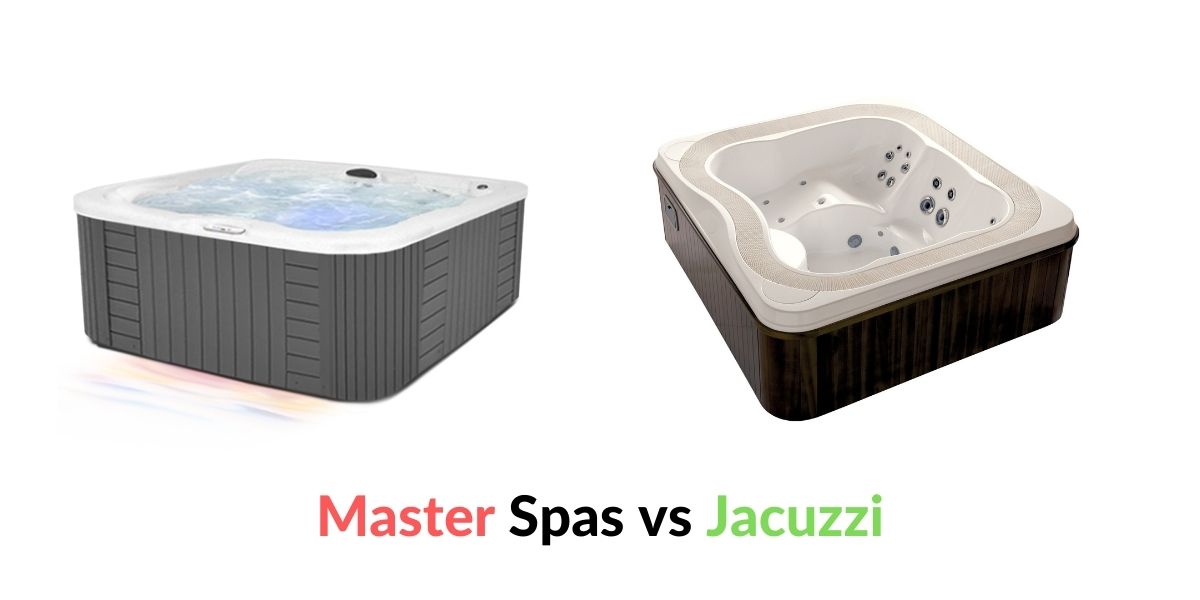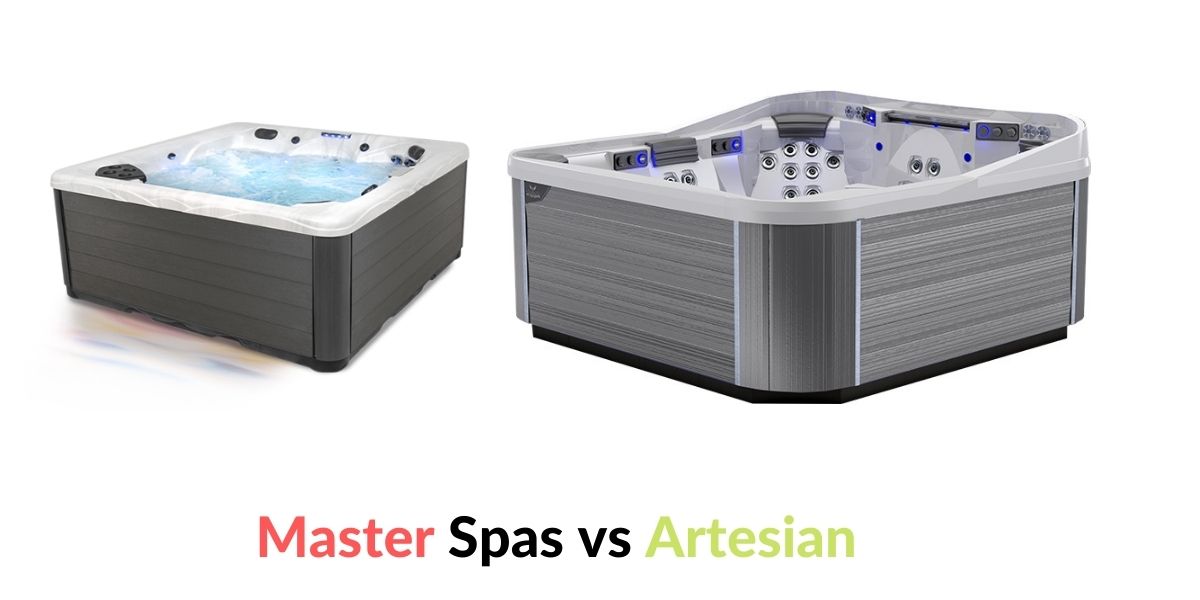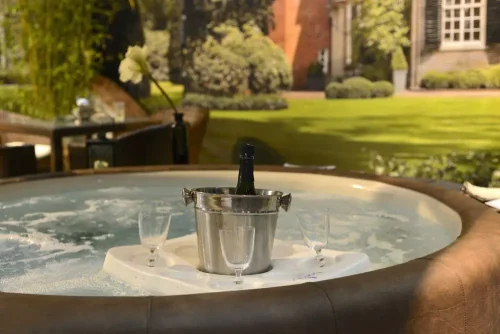Hot Tub Ozone v Ultraviolet: A Comparison for Cleaner Water
What are the differences between hot tub ozone v ultraviolet sanitation systems?
What is the difference between hot tub ozone vs ultraviolet for sanitation? Hot tub ozone systems use ozone gas to kill bacteria and viruses in the water, while ultraviolet systems pass water through ultraviolet light to disinfect it. Ozone is more effective at killing a wider range of organisms, but ultraviolet is easier to maintain and doesn’t leave residual ozone in the water.
Key Highlights
Keeping your hot tub water clean and safe is super important. There are a few ways to do this, like using your own chlorine, UV light, ozone gas, or even saltwater systems.
- With UV sterilization, ultraviolet light zaps away bacteria and tiny unwanted guests in the water.
- Ozone gas acts as a powerful oxidizer. It’s really good at cleaning up the spa water without leaving anything behind.
- Saltwater systems take salt and turn it into chlorine which then cleans the hot tub water.
- Various Jacuzzi hot tubs mix together ozone gas and UV-C technology to make sure their spa water is extra clean.
This unique combination of ozone and other methods ensures that you’re soaking in safe and sanitary conditions every time

Introduction
Before you dive into the world of hot tub ownership, it’s important to understand hot tub care, especially when it comes to popular types of sanitation. Not only does this matter for your own health, but it also plays a big part in keeping your hot tub running well for years.
In our discussion today, we’re going to look at two common approaches: ozone and UV sterilization. Both these methods do an excellent job at getting rid of germs and tiny critters in the water; however, they tackle the problem differently. By looking into how each method works along with their benefits and drawbacks, you’ll be better equipped to choose which one fits best for keeping your hot tub’s water crystal clear using either ozone or UV sterilization.
Understanding Proper Sanitation of Your Hot Tub
A solid sanitation system helps get rid of unwanted guests to make sure the hot tub water stays safe and ready to enjoy. This system tackles dead skin cells and oils by breaking them down. This can feed bacteria if left unchecked.
Of course, you can do nothing however, you will need to change the water very regularly.
Common Sanitization Methods: A Brief Overview
When it comes to keeping hot tubs clean, there are various technologies that you can use. For starters, chlorine is a go-to choice. It’s the same chemical that many use in swimming pools and does a great job of killing germs and other tiny invaders in the water. But, with its strong smell and potential for irritating skin and eyes, it’s not everyone’s favorite.
Then there’s the saltwater system option. This method pulls off a neat trick by making chlorine from salt which some folks find cooler because it feels more natural and is kinder to our planet. Still, even this way has chlorine lurking in the waters.
Moving on to other tech-savvy methods like ozone gas and UV sterilization – these guys take on germs without leaning so heavily on chemicals such as chlorine. Using ozone or ultraviolet light helps zap away bacteria effectively while allowing you to use less chemicals.
The Science Behind Ozone Sanitization
Ozone sanitization uses ozone gas, a strong cleaner. Ozone is just three oxygen molecules stuck together (O3) and gets made when you zap regular oxygen with high voltage electricity through something called corona discharge. This breaks the oxygen up and then puts it back together as ozone.
The ozone reacts super fast to break down things like bacteria in hot tub water because it’s really good at taking apart organic matter. By putting this gas into the hot tub water, it cleans out all the microscopic debris, making sure your hot tub stays nice and clean.
How Ozonator Generators Work in Hot Tubs
In hot tubs, they use something called an ozone generator to clean the water. This gadget works by making ozone gas through a method known as corona discharge (CD). Here’s how it works: A strong electric spark is sent across a special kind of material like ceramic or glass. This action changes regular oxygen in the air into ozone.
After that, this created ozone gas gets mixed into the hot tub water using a specific jet made just for this purpose. When the ozone mixes with the water, it starts attacking and breaking down stuff like dirt and germs because of its super reactive nature. Ozone has got this power because it’s made up of single atoms which are really good at cleaning things up. By having an ozone generator, people who own hot tubs don’t have to rely so much on harsh chemicals to keep their hot tub water nice and clean.
Advantages of Using Hot Tub Ozonator for Water Sanitation
Using ozone to keep hot tub water clean has a bunch of benefits. For starters, ozone is really good at breaking down bacteria and other tiny organisms because it’s a powerful oxidizer. This means it can make the water in your hot tub super clean.
With ozone, you don’t have to work as hard to keep things clean. Ozone generators do their thing on their own, making this gas that helps clean the water without needing much from you. So, not only does this save time but also keeps your hot tub ready for a dip anytime with less effort.
On top of all that, when you use ozonated water in your hot tub , it ends up feeling cleaner and fresher than if you were using regular chemicals. There’s no weird smells or tastes left behind by chlorine or anything else – just nice clearwater . If keeping your easy while still having crystal-clear waters sounds good then going the route might be right up alley!
Exploring Ultraviolet (UV) Water Treatment
Using ultraviolet (UV) light is another way to keep hot tub water clean. This method involves using a special kind of UV light, known as germicidal UV-C rays, which are really good at killing germs and tiny life forms in the water by messing up their genetic material so they can’t multiply.
With this approach, the UV light doesn’t mix with the water people soak in. Instead, it’s kept inside a special part of the hot tub’s pipes called a sterilization chamber. By doing this, those soaking in the hot tub aren’t exposed to any harmful effects from the UV rays but still get to enjoy nice and clean water. Choosing UV sanitization means you’re going for an option that doesn’t rely on chemicals and is better for our planet when taking care of your hot tub.
The Process of UV Water Treatment in Hot Tubs
In hot tubs, UV water treatment uses germicidal light rays from a UV light to get rid of bacteria and tiny life forms in the water. This special light is kept inside a sterilization chamber that’s part of the hot tub’s pipes. When water flows through this chamber, it gets blasted with powerful UV-C rays. These rays mess up the DNA or RNA inside these organisms, stopping them from multiplying.
Using UV for cleaning your hot tub is both chemical-free and good for the planet. It doesn’t add any extra chemicals to your hot tub water, which makes it an attractive option for those who prefer keeping things natural when cleaning their spa. But remember, even though UV takes care of germs without chemicals, you might still need some other products to help keep the water clear and well-balanced.
Benefits of Choosing UV Light for Water Purification
When you pick UV light to clean your hot tub water, you’re in for some real perks. For starters, UV light is awesome at getting rid of germs and tiny life forms in the water, making sure it’s really clean. This means you won’t have to use those usual chemicals to keep the water safe.
With UV light systems, there’s hardly any work needed from whoever are the owners of these spas. After setting it up, these systems just do their thing on their own, keeping the water clean all the time without anyone having to fuss over it. So basically, this saves a lot of time and keeps your hot tub ready for whenever you need it.
On top of that, when your hot tub uses UV treatment for its water purification process ,the resulting experience is way better because there aren’t any leftover chemicals or unwanted stuff in the water which makes soaking more pleasant . Not having harsh chemicals also means less chance of skin problems or allergies popping up.
So by going with a UV approach for cleaning out your hot tub, not only does everything get simpler but also cleaner and gentler too!
Hot tub ozone v ultraviolet: Key Differences
I am often asked which is best, hot tub ozone vs ultraviolet to keep hot tub water clean. They both do a great job at getting rid of germs, but they work differently. Ozone gas is really good at breaking down stuff like dirt in the water because it’s a strong cleaner made through something called corona discharge. It makes sure the water stays sanitized. On the flip side, UV light kills germs by messing up their DNA or RNA with its UV-C rays so they can’t grow anymore. But since UV light doesn’t clean the water itself, you might need to use some extra chemicals.
When it comes to Jacuzzi hot tubs, they mix ozone and UV-C technology together for an even better cleaning system that keeps your hot tub water super clear. This combo means you get both sanitization from ozone and oxidation from UV-C tech working hand in hand for a top-notch soak every time.
Effectiveness in Killing Bacteria and Viruses
Ozone and UV light both do a great job at getting rid of germs like bacteria and viruses in hot tub water. Ozone is really strong at breaking stuff down, especially organic things, which helps it kill off harmful tiny organisms quickly. It does this by attacking the outer layers of bacteria and viruses, making them stop working and unable to spread.
On the other side, UV light messes with the genetic material inside these microorganisms. This stops them from multiplying and eventually kills them. The kind of UV light we’re talking about here is called germicidal light or specifically UV-C rays that are used in a sterilization chamber to clean up the water really well.
While both ways work well for cleaning hot tub water, ozone has an extra benefit as it can also break down non-living stuff floating around in there because it’s such a powerful oxidizer. However, since UV light doesn’t help with clearing out these substances from the water on its own; you might need some additional chemicals to keep everything balanced properly.
Practical Considerations for Hot Tub Owners
When thinking about keeping a hot tub clean, owners have to think about several key things. These are how much different methods might cost, what you need to do to set them up, and how much work it takes to keep them going.
With ozone and UV light systems for cleaning the water, prices can be different. Usually, setting up an ozone generator costs more at the start than installing a UV system that needs a special part in the plumbing called a sterilization chamber.
Looking after both types of systems isn’t too hard since they mostly run on their own with just a bit of checking from you. But it’s still important to regularly check your hot tub’s water balance and cleanliness levels no matter which system you use.
By paying attention to these practical points like installation requirements and ongoing maintenance alongside comparing costs between ozone generators and UV light systems, choosing the right way to keep your hot tub clean becomes easier. This helps ensure that whatever method is chosen fits well with what each owner needs or prefers for their hot tub‘s upkeep and mazimises the longevity of their hot tub.
Cost Comparison: Hot tub ozone vs Ultraviolet
One important consideration when choosing between ozone and UV sanitization is the cost. While both systems require some investment, there are differences in the long-term expenses.
UV systems typically require a UV-C bulb replacement every 12-18 months. The cost of these replacement bulbs can vary depending on the brand and model of the hot tub. On the other hand, ozone generators have a longer lifespan and may only require replacement every 3-5 years.
In terms of overall hot tub longevity, both UV and ozone systems can help extend the life of your hot tub by reducing the amount of chemical usage. With proper maintenance and regular care, a hot tub equipped with either system can last for many years.
To better understand the cost comparison, let’s take a look at the estimated costs for UV and ozone systems over a 5-year period:
| UV System | Ozone Generator | |
| Initial Cost | $$$ | $$ |
| Bulb Replacement | $$$$ | $$ |
| Total Cost | $$$$$ | $$$ |
Keep in mind that these costs are estimates and can vary depending on factors such as the brand, model, and location. It’s always a good idea to consult with your local hot tub local dealer for more accurate pricing information.
Installation and Maintenance Requirements
When we look at setting up and looking after ozone and UV systems, they’re not quite the same.
With UV systems, you need to put in a sterilization chamber right into the hot tub’s pipes. This spot is where the UV-C bulbs live, making sure those uv rays stay out of your hot tub water. Setting this up might mean you have to mess with some plumbing stuff, so getting a pro to do it is probably best.
For keeping a UV system going strong, all you really need to do is swap out the UV-C bulbs every year or so – something either you or someone who knows what they’re doing can handle pretty easily.
On another note, for an ozone system to work its magic in your hot tube water , there needs be something called an ozonator hooked up that sends ozone into the water through one of jets . You might have replace this gadget every few years based on how much use it gets .
As far as everyday upkeep goes,ozone setups tend be easier deal with than their Uv counterparts.This mainly because Ozone acts like powerful oxidizer cleaning away impurities more efficiently meaning less maintenance overall.
User Experiences with Ozone and UV Sanitization
A lot of people who own today’s models of hot tubs have talked about how great ozone and UV sanitization systems are.
With an ozone system, folks find their hot tub water not only cleaner but also say they don’t have to use as many chemicals. They mention the water feels and smells better, which is a big plus for those wanting something that’s kinder to the environment.
On the other hand, UV sanitization has its fans too. The strong UV-C light zaps away bacteria and germs, making users feel more at ease and provide for safe soaking. Some even notice their hot tub water looks clearer and they don’t have to clean it as much when using a UV system.
These stories really show us how both ozone and UV can make keeping your hot tub clean easier while cutting down on chemical usage. Picking the right one could mean having nicer, safer water in your hot tub.
Success Stories from Hot Tub Owners
People who own hot tubs and use ozone or UV light to keep them clean have really good things to say about their choices.
For instance, someone with an ozone system shared how they don’t need as many chemicals anymore. Their hot tub water stays fresh and clear without much work because the ozone does a great job of breaking down impurities.
On the other hand, a person who went for a UV light system noticed their water got better right away. They’re not stressed about germs or tiny critters in their hot tub water now. The UV light makes them feel extra safe.
These stories show that using ozone or UV sanitization can make taking care of your hot tub easier and healthier by cutting down on chemical use.
Challenges and Solutions in Real-Life Applications
While using ozone and UV light to keep hot tubs clean has its perks, there are a few hurdles that might pop up.
With ozone gas, one issue is it can damage the soft plastic parts of your hot tub like the cover and pillows. To avoid this, you just need to make sure the amount of ozone used is right and check on your hot tub’s parts now and then.
On the other hand, for UV systems, since UV light doesn’t help in cleaning the water by itself (it doesn’t oxidize), you’ll have to use something else like a non-chlorine shock product or different oxidizing agents to get the job done.
Knowing these challenges ahead of time means you can deal with them easily. That way, anyone owning a hot tub can enjoy all that these sanitization methods offer without running into big problems.
Expert Opinions on Hot Tub Sanitation
People who know a lot about hot tubs have shared their advice on how to keep the water clean. They say that using either ozone or UV systems can really help in keeping the hot tub water just right. But, they also stress that it’s super important to take care of these systems by doing what’s recommended.
For any kind of sanitation system you’re using, checking and adjusting the water often is key to making sure it stays nice and safe for everyone. Also, if you’ve got an ozone or UV system, make sure to use it like the company says you should.
By listening to what these experts suggest and taking good care of your hot tub, you’ll be able to enjoy water that’s both clean and safe.
What Professionals Say About hot tub ozone v ultraviolet?
Experts in the hot tub field have shared their thoughts on using hot tub ozone v ultraviolets to keep hot tub water clean. They say that ozone generators are great because they can really break down unwanted bacteria in the water thanks to their strong oxidizing abilities. However, if you go with ozone, you’ll need to stay on top of maintenance and watch your ozone levels closely so nothing bad happens to your hot tub.
On another note, UV sanitization is known for getting rid of bacteria and other tiny harmful things without having to use chemicals. This gives an extra sense of security for those who own a hot tub. But since UV light doesn’t oxidize, you might need something else along with it to make sure the water stays nice and clear.
In conclusion, folks working with hot tubs believe both methods do a good job at keeping the water safe and clean. Whether someone prefers one over the other depends on what they’re looking for or what specific issues they want addressed in maintaining their hot tub‘s cleanliness.
Recommended Practices for Optimal Water Quality
To keep your hot tub’s water just right, no matter what kind of sanitation system you’re using, here are some tips to follow:
- Regularly check and adjust the water. This means keeping an eye on things like pH levels, alkalinity, and how much sanitizer is in there.
- Make sure to clean out any leaves or dirt and give the filters a good wash often.
- Stick to what the maker of your hot tub says about taking care of it with ozone or UV systems.
- With ozone systems, watch those levels closely so they don’t mess up parts of your hot tub.
- If you’ve got a UV system working for you, throw in something extra like a non-chlorine shock every now and then to make sure everything stays fresh.
- Talking with an expert or swing by your local hot tub dealer could also give you more tailored advice.
By sticking with these steps, anyone can keep their spa water perfect for relaxing dips anytime.
Conclusion
Wrapping things up, when it comes down to picking between ozone and ultraviolet for keeping your hot tub water clean, it really hangs on what you’re looking for and what you like. Each method does a great job at making sure the water in your hot tub stays sparkling. By getting a grip on how each technology works, weighing out stuff like how much they’ll cost you over time and the effort needed to keep them going, plus hearing from people who’ve already given them a go can help big time in choosing wisely. No matter if you lean towards hot tub ozone v ultraviolet, sticking to regular upkeep and doing things by the book is key to having top-notch water quality that makes every dip enjoyable.
Frequently Asked Questions
Which Is More Effective for My Hot Tub Ozone v ultraviolet?
When it comes to keeping hot tub water clean, both ozone and UV light systems have their perks. It really boils down to what you’re looking for and your particular needs. Ozone acts as a strong cleaner by breaking things down, whereas UV light takes care of germs and tiny critters in the water. To figure out which one will work best for your hot tub, it might be a good idea to chat with your local hot tub dealer who can guide you based on what’s needed specifically for your setup.











